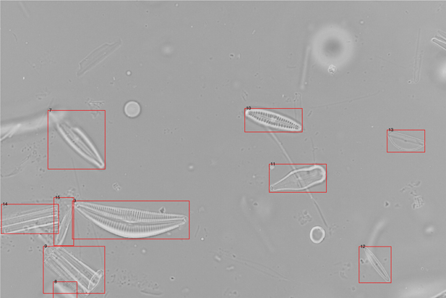Automated Detection and Classification of the Diatom Microscopic Photo Images
Main Article Content
Abstract
Article Details

This work is licensed under a Creative Commons Attribution 4.0 International License.
Authors who publish with this journal agree to the following terms:- Authors retain copyright and grant the journal right of first publication with the work simultaneously licensed under a Creative Commons Attribution License that allows others to share the work with an acknowledgement of the work's authorship and initial publication in this journal.
- Authors are able to enter into separate, additional contractual arrangements for the non-exclusive distribution of the journal's published version of the work (e.g., post it to an institutional repository or publish it in a book), with an acknowledgement of its initial publication in this journal.
- Authors are permitted and encouraged to post their work online (e.g., in institutional repositories or on their website) prior to and during the submission process, as it can lead to productive exchanges, as well as earlier and greater citation of published work (See The Effect of Open Access).
References
Bukhtiyarova L. N. “Bacillariophyta v biomonitoringe rechnykh ekosistem. Covremennoye sostoyaniye i perspektivy ispol'-zovaniya [Bacillariophyta in the biomonitoring of river ecosystems. Current state and prospects of use]”, Al'gologiya, vol. 9, no. 3, pp. 89–103, 1999.
Bukhtiyarova L. N. “Classification of diatom algocoenoses as a useful tool in river biomonitoring. In: J. Prygiel, B. A. Whitton, J. Bukowska (eds) Use of algae for Monitoring Rivers. III”. – Agence de l'Eau Artois-Picardie, p. 114–121, 1999. URL: https://www.researchgate.net/publication/282974818_Classification_of_diatom_algocoenoses_as_a_useful_tool_in_river_biomonitoring
Treguer R., Nelson D. M., Van Bennkom A. J. “The silica balance in the world ocean: a reestimate”, Science, vol. 268, p. 375–379, 1995. URL: https://www.researchgate.net/ publication/6092964_The_Silica_Balance_in_the_World_Ocean_A_Reestimate
The European Parliament and the Council of the European Union. Directive 2000/60/EC. Establishing a Framework for Community Action in the Field of Water Policy; Official Journal of the European Community: Maastricht, the Netherlands, Work Safety Introduction, 2000. URL: https://injuryfacts.nsc.org/work/work-overview/work-safety-introduction/.
Lobo E., Heinrich C., Schuch M., Wetzel C., Ector L. “Diatoms as Bioindicators in Rivers”, River Algae, vol. 06, p. 245–271, 2016. https://doi.org/10.1007/978-3-319-31984-1_11
Wang Yi-K., Stevenson R., Sweets R., DiFranco J. “Developing and testing diatom indicators for wetlands in the Casco Bay watershed, Maine, USA” Hydrobiologia, vol. 561, no. 191, p. 245–271. 2006. DOI: 10.1007/s10750-005-1614-2
Stevenson R., Pan Y., Van Dam H. “Assessing environmental conditions in rivers and streams with diatoms”. In: Smol J. P. and Stoermer E. F. (Eds.) – The Diatoms: Applications for the Environmental and Earth Sciences. Cambridge, UK, Cambridge University Press, p. 57–85, 2010. DOI: 10.1017/CBO9780511763175.005.
Mayama S., Katoh K., Omori H., Seino S., Osaki H., Julius M., Lee J. H., Cheong C., Lobo E. A., Witkowski A., Srivibool R., Muangphra P., Jahn R., Kulikovskiy M., Hamilton P. B., Ya-Hui G., Ector L., Soeprobowat T. R. “Progress toward the Construction of an International Web-based Educational System Featuring an Improved "SimRiver" for the Understanding of River Environments”, Asian Journal of Biology Education, vol. 5, p. 2–14. 2011. URL: http://www.u-gakugei.ac.jp/~mayama/PDF/Mayama et al_2011_SimRiver_AJBE.pdf
Dimitrovski I., Kocev D., Loskovska S., Dzeroski S., “Hierarchical classification of diatom images using ensembles of predictive clustering trees”, Ecological Informatics, vol. 7, p. 19–29, 2012. URL: http://kt.ijs.si/DragiKocev/ECOINF/ECOINF_diatom_images.pdf
Bueno G., Deniz O., Pedraza A., Ruiz-Santaquiteria J., Salido J., Cristóbal G., Borrego-Ramos M., Blanco S., “Automated Diatom Classification (Part A): Handcrafted Feature Approaches,” Applied Sciences, vol. 7, no. 8, p. 753, 2017. URL: http://digital.csic.es/bitstream/10261/153574/1/applsci-07-00753.pdf
Pedraza A., Bueno G., Deniz O., Cristóbal G., Blanco S., Borrego-Ramos M. Automated Diatom Classification (Part B): A Deep Learning Approach, – Applied Sciences vol 7, p. 460, 2017. DOI: 10.3390/app7050460
Quantitative image analysis of microstructures. Exner H. E., Hougardy H. P. (Eds). DGM Informations‐gesellschaft Verlag, Oberursel, 235 pp., 1988. ISBN 3‐88355‐132‐5 DOI: 10.1002/adma.19900020216
Glasbey C. A., Horgan G. W. “Image analysis for the biological sciences”, Wiley J., Sons, Inc. New York, NY, USA, 230 pp. 1995. ISBN: 0-471-93726-6 DOI: 10.1017/S0021859600088924
Zheng J., Zhang D., Huang K., Sun Y., Tang S., “Adaptive windowed range-constrained Otsu method using local information”, Journal of Electronic Imaging, vol. 25, p. 013034 , 2016, DOI: 10.1117/1.JEI.25.1.013034
Jung A. “Imgaug”, 2017. URL: https://github.com/aleju/imgaug.
Iandola F. N., Han S., Moskewicz M. W., Ashraf K., Dally W. J., Keutzer K. “SqueezeNet: AlexNet-level accuracy with 50x fewer parameters and
Simonyan K., Zisserman A. “Very deep convolutional networks for large-scale image recognition”. arXiv preprint, 2014. arXiv: 1409.1556





